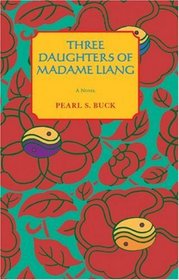Helpful Score: 1
In Madame Liang, Buck has created a fascinating character, a woman who is very much her own person. After doing the very un-Chinese thing of leaving her husband when he takes a concubine, which he claims is his right because his wife has produced no son, Madame Liang determines to make her own way in the world and opens a gourmet restaurant that caters to the high and mighty of the People's Republic. She has not only survived, but thrived, by keeping a low profile and providing her customers with the best. But she has sent her three daughters, Grace, Mercy and Joy, to America to be educated; and now, after many years separation, Grace has been called home by her government to serve the new society.
Madame Liang has her own opinions about the new society, which she has prudently kept to herself. But Grace, back home in China, throws herself into her work as a doctor and embraces everything blindly, including a young physician named Liu Pang, who parrots everything he has read in Mao's Little Red Book. Mercy, the second sister, misses her home and induces her new husband, a rocket scientist, to return to their country. Meanwhile, the third sister, Joy, remains in America.
Buck writes with a flow that keeps her book moving effortlessly along, covering some six or seven years from the end of the 50's to 1966. Through it all, Madame Liang's continually expressed faith in her country and people suggest that, whatever her own fate, China and its people will survive in spite of themselves. Although the book is ostensibly about her three daughters, it's really the story of a remarkable woman, and through her, the story of China in transition.
Madame Liang has her own opinions about the new society, which she has prudently kept to herself. But Grace, back home in China, throws herself into her work as a doctor and embraces everything blindly, including a young physician named Liu Pang, who parrots everything he has read in Mao's Little Red Book. Mercy, the second sister, misses her home and induces her new husband, a rocket scientist, to return to their country. Meanwhile, the third sister, Joy, remains in America.
Buck writes with a flow that keeps her book moving effortlessly along, covering some six or seven years from the end of the 50's to 1966. Through it all, Madame Liang's continually expressed faith in her country and people suggest that, whatever her own fate, China and its people will survive in spite of themselves. Although the book is ostensibly about her three daughters, it's really the story of a remarkable woman, and through her, the story of China in transition.
The first half of this book had me hooked, but then it dragged toward the end. I kept waiting for the climax or something to happen. I didn't enjoy this quite as much as the other Pearl Buck books I have read. My favorite was The Good Earth.
FYI...the book has no chapters...just a few blank lines between each scene.
FYI...the book has no chapters...just a few blank lines between each scene.
ISBN showing inside book is: 671-77312-7
Pocket book edition from 1971
Pocket book edition from 1971




